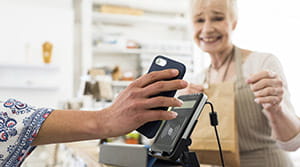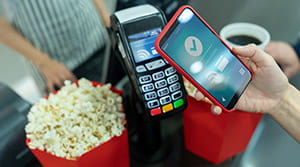Understanding Your Digital Wallet - and Six Ways to Keep it Safe

Digital wallets, also called mobile wallets, are systems that provide a secure, alternative way to pay using an app on your phone or other device, rather than pulling out your card at the register. Apple Pay®, Samsung Pay® and Google Pay® are some of the most popular digital wallet apps. If you’re on the fence about whether to start using this technology, you’re not alone. Confusion about how it works is among the top reasons U.S. consumers are not adopting this new method, according to a 2017 study by PYMNTS.com, a leading news and services provider in the payments industry.
If more information is what you’re looking for, we can help.
How digital payments work
Once you add one of the payment apps to your mobile device, such as a smartphone or watch, and load necessary information, you’re ready to start using it. When you initiate a payment, your device interacts with a merchant’s payment terminal in one of two ways: by Magnetic Secure Transmission (MST) or Near Field Communication (NFC). Apple and Android devices use MST, while Samsung devices use both. These technologies transmit your card information to the payment terminal directly, without swiping or inserting your card into a card reader.
Protecting your financial information
Both technologies use cutting-edge security to protect your information. They use a digital token, usually a 15- to 16-digit number, rather than your card number, so your information is never stored on your phone or transmitted to the merchant. The token information is stored by a token service provider—typically a bank or credit card company that has robust security systems designed to protect this information.
What can you do to protect your digital wallet?
You are your best advocate when it comes to the safety of your digital wallet. Here are six steps you can take:
- Protect your smartphone or watch with a password, fingerprint or other biometric authentication
- Don’t use public Wi-Fi to access sensitive data. Public Wi-Fi isn’t secure, creating the opportunity for thieves to access your information
- Be suspicious of malicious software. There are many digital payment apps out there—only download apps from reputable companies
- Be vigilant. When using your smartphone, avoid clicking random links in texts or emails. The sender’s phone or email account could be compromised and sending malicious links to you without their knowledge
- Enable your phone’s security features and keep them updated—this is the first line of defense between your information and hackers
- Keep an eye on your accounts. Just as you do when using checks and debit cards, watch your bank and credit card statements and immediately report any suspicious activity
To learn more about staying safe online, visit our Banking Security page.
























